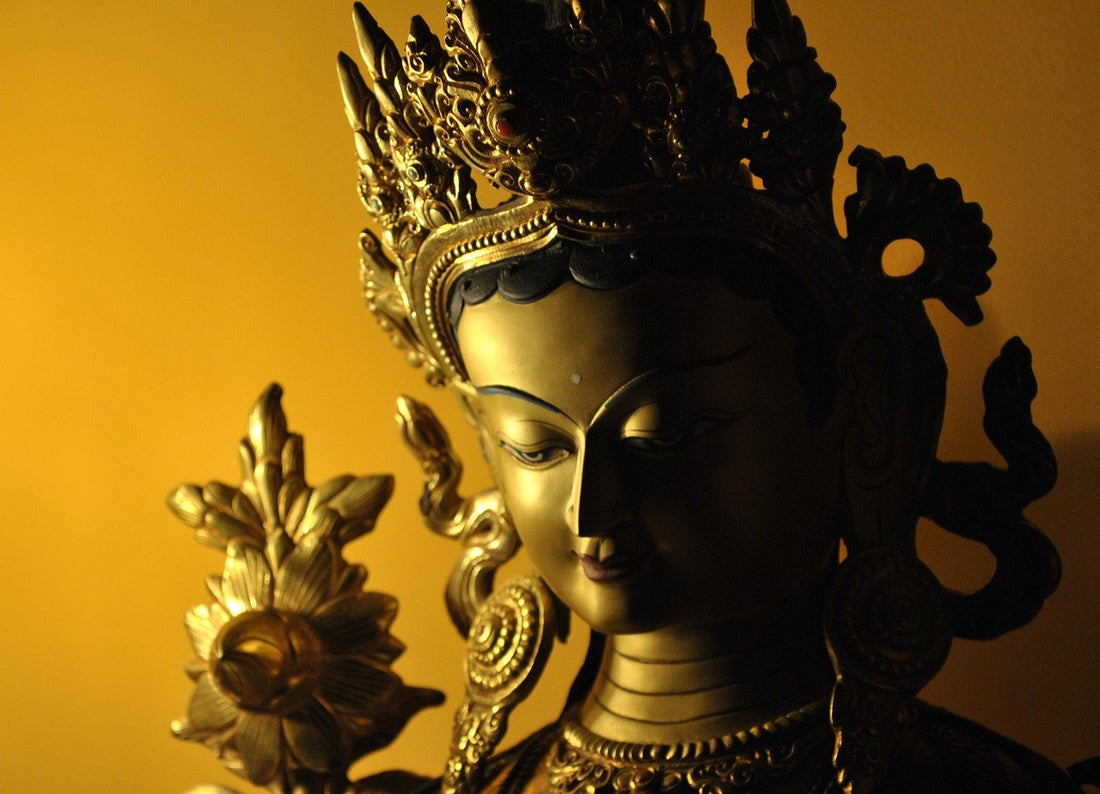Origin Story of Tara
Tara is the Buddhist savior goddess who is very popular in Nepal, Tibet and Mongolia. There are two popular origin myths surrounding Tara's creation. The first is that she sprung from the tear of Boddhisattva Avalokiteshvara, the Bodhisattva of Compassion. The tear fell to the ground and formed a lake, and from the water rose up a lotus which opened to reveal the goddess.
The second story begins with Tara as a princess named Yeshe Dawa who lived in a time long ago. For many lifetimes, she made offerings to the Buddha and, after doing this for so many years, she received the instructions about the bodhicitta (the consciousness of a bodhisattva). After reaching such a high level of consciousness, the monks suggested that she pray to be reborn as a male in order to reach enlightenment. However, the princess disagreed. She responded that from the point of view of true enlightenment, there is no separation between male and female. She thus vowed to always be born as a female bodhisattva until samsara (the cycle of death and rebirth) ended.
After this declaration, she went into a deep state of meditation for thousands of years and was able to free millions of beings from suffering with her practice. Seeing this, the Buddha decided that she will henceforth manifest supreme Buddhahood and be known as the Goddess Tara.
What Does Tara Do?
Tara is the protector of navigation and earthly travel. She also helps guide spiritual travel along the path to enlightenment. In Tibetan Buddhism, Tara is believed to be the incarnate of every pious woman and the two wives of the first Buddhist King of Tibet- a Chinese princess and a Nepali princess. These two women are represented by the White Tara and Green Tara.
Tara's Many Forms
White Tara, the Chinese princess, symbolizes purity and is often represented standing at the right hand of Avolokiteshvara, or seated with her legs crossed (full lotus position) while holding a lotus flower. In Sanksrit, White Tara is called "Sita Tara" and "Sgrol-dkar" in Tibetan. In Mongolia, there is a popular form of White Tara known as the “Tara of Seven Eyes”. In this form, White Tara has a third eye on her face, an eye on each palm of her hands, and one on each of the soles of her feet, giving her seven eyes in total. The seven eyes symbolize her dedication and ability to see all the suffering throughout the world.
Green Tara, the Nepali princess, is sometimes considered to be the original Tara. Green Tara is also called "Shyama Tara" in Sanksrit and "Sgrol-ljang" in Tibetan. She is generally seated on a lotus throne with her right leg hanging down, wearing the ornaments of a bodhisattva, and holding a closed blue lotus (utpala).
The contrast between White and Green Tara symbolizes the unending compassion of a deity who labors all day and night to relieve suffering.

The beloved goddess Green Tara is enshrined within this richly decorated pendant. Sterling silver with turquoise and coral accent stones. Made in Nepal.
Green Tara is the feminine embodiment of enlightenment and a manifestation of the Buddha-nature that exists in all of us. Her female form represents wisdom, and she is called the Mother of all Buddhas. Tara comes swiftly to the aid of those in need. She is the liberator from karmic obstacles and fear.
This devotional image for your shrine or other sacred space is a detail from a Tibetan thangka depicting the beloved goddess Green Tara, who protects beings from obstacles and fear. It is hand printed on tumbled Italian marble. Natural variations in the marble and the surface of the prints enhance the unique, aged look of the art tile.





